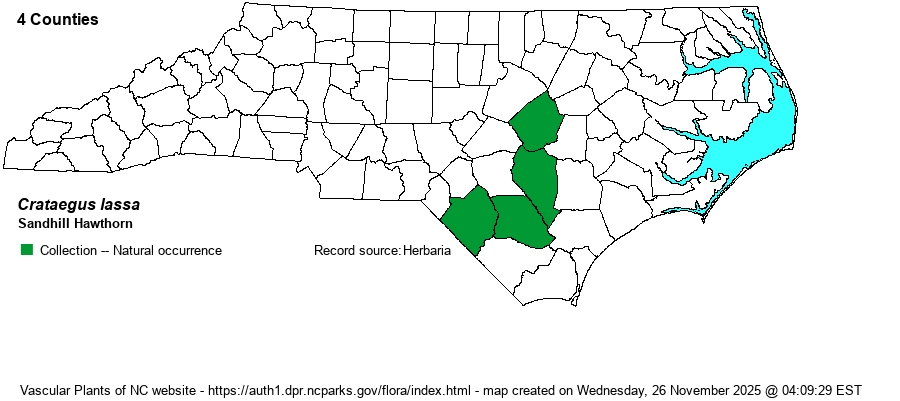| Author | Beadle | |
| Distribution | Occurs in the central and southern Coastal Plain and apparently into the southeastern portion of the Piedmont, based on the range map in Lance (2014). However, all collections so far are from the central/western Coastal Plain, just east of the Sandhills region. Obviously, the range map below is highly incomplete.
This species, which consists of a number of varieties, ranges from southeastern NC south to central FL and AL, primarily in the Coastal Plain.
| |
| Abundance | Apparently uncommon to infrequent in the southwestern Coastal Plain, and possibly also in the Sandhills and adjacent Piedmont. Abundance needs further study. The NCNHP database contains very few of the Crataegus species listed in Weakley (2018) for the state; therefore, this website has assigned an S3? state rank for this species, based on the apparent range and abundance. | |
| Habitat | This hawthorn is found in dry and sandy soil, perhaps growing in deeper sands than any other in this large genus. It favors pine/scrub oak sandhills, and other sandy uplands, often in at least partial (if not full) sun. |
| Phenology | Flowers mainly from late March into April, and fruits in August and September. | |
| Identification | This is a large shrub, often with several stems, to rarely a small tree. In the open it shows noticeably drooping branches and looks a bit disheveled. It has oblanceolate or narrowly obovate leaves, with a long and entire tapering base. The outer margin toward the tip is rounded and shallowly scalloped – appearing as a narrow fan-shaped or spoon-shaped leaf. Also, it has very few flowers in a cluster. See Lance (2014) and Weakley (2018) for more characters. As this “species” is really comprised of a bunch of similar taxa grouped together, there is much variation in characters of C. lassa. But, if you run across a hawthorn in xeric sands of a scrub oak forest stand, and the leaves are quite wedge-shaped with a rounded distal end, you may have this species. | |
| Taxonomic Comments | Lance (2014) admits that a number of older named species have been grouped together into one of older names – C. lassa. That is the reason for as many as five varieties for C. lassa, of which four of the five are found in eastern NC. Weakley (2018) also lists four varieties in NC. This was one of many taxa included within the large C. flava in RAB (1968).
| |
| Other Common Name(s) | Rebel Hawthorn | |
| State Rank | [S3?] | |
| Global Rank | G4G5Q | |
| State Status | | |
| US Status | | |
| USACE-agcp | | |
| USACE-emp | | |

